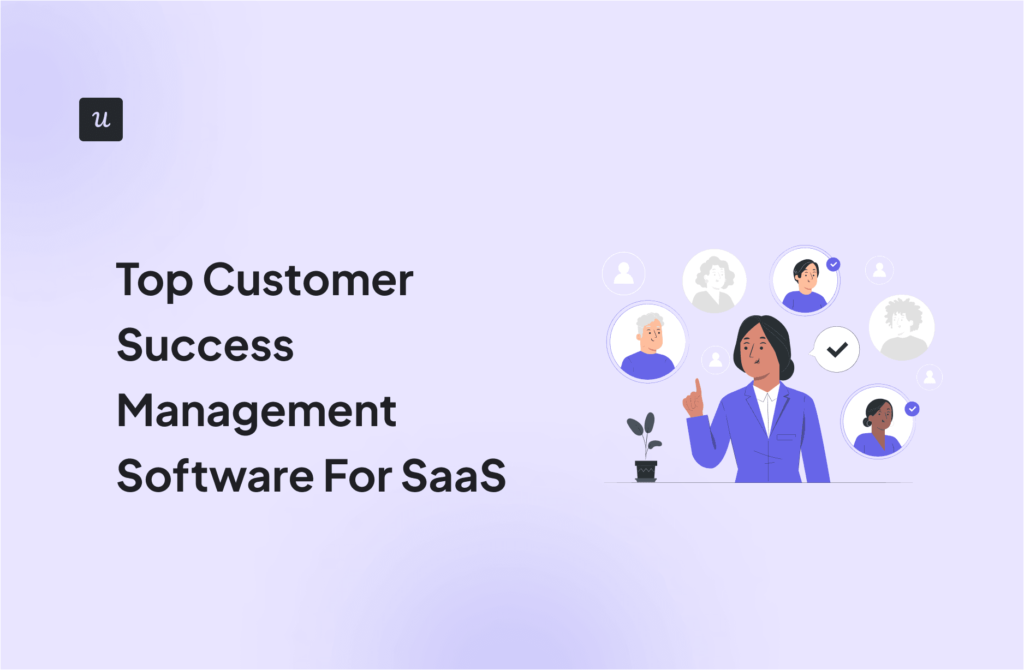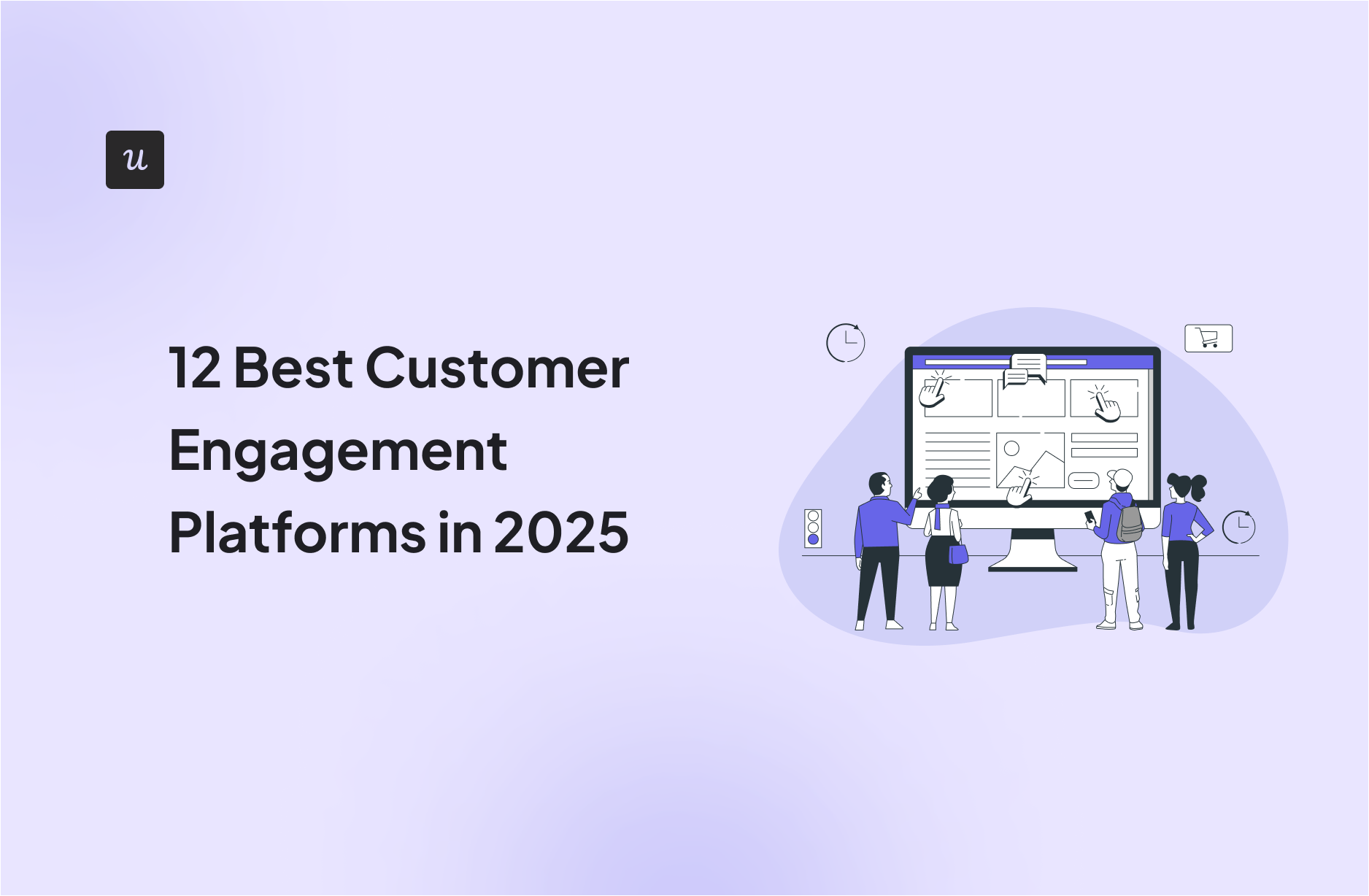
Try Userpilot Now
See Why 1,000+ Teams Choose Userpilot

What’s a customer engagement platform?
A customer engagement platform (CEP) is a tool designed to help businesses manage and improve interactions with their customers across various touchpoints.
The aim of such platforms is to create a positive customer experience and foster strong relationships between a brand and its customers.
What is your primary goal with a customer engagement platform?
How would you describe your team’s technical resources?
Which of these best describes your company?
Find the best customer engagement platform for your needs.
Based on your answers, a tailored solution can help you achieve your goals. See how Userpilot can help you build the best customer experiences without writing any code.
12 Best customer engagement platforms for SaaS companies
With a variety of platforms offering a plethora of different features, we’ve listed below 12 of the finest customer engagement platforms for SaaS companies.
| Platform | Best For | Key Features | Pricing | G2 Rating |
|---|---|---|---|---|
| Userpilot | In-app customer engagement | UI patterns, triggers, AI assistant, A/B testing, auto capture, dashboards | Starter: $299/mo(billed annually); Growth/Enterprise: Custom | 4.6/5 |
| UserGuiding | Small businesses | Guides, checklists, resource center | Basic: $89/mo; Pro: $389/mo; Corporate: $689+/mo | 4.7/5 |
| Pendo | Mobile apps | Auto-guides, flow triggers, AI chatbot | Freemium (limited); Starter: $7,000/year; Custom | 4.5/5 |
| MoEngage | AI in-app messaging | Personalization tools, omnichannel campaigns, AI optimization | Free (10K MTUs); Growth/Enterprise: Custom | 4.5/5 |
| Whatfix | Employee engagement | Walkthroughs, on-demand support, pop-ups | Standard, Premium, Enterprise: Custom | 4.6/5 |
| HubSpot | CRM | Centralized engagement, ticket automation | Free; Starter: $15/mo; Enterprise: $130/mo | 4.4/5 |
| Zendesk | Omnichannel engagement | Voice integration, conversational CRM | Team: $55/mo; Pro: $115/mo; Enterprise: Custom | 4.2/5 |
| Drift | Sales and marketing teams | Prospecting tools, live chat, AI chatbots | Premium: $2,500/mo; Advanced/Enterprise: Custom | 4.4/5 |
| Kangaroo | Loyalty programs | Gamification, marketing automation | Essential: $59/mo; Plus: $299/mo | 4.8/5 |
| Intercom | Chatbot-driven engagement | Multilingual chat, seamless handoff, help center | Essential: $39/mo; Expert: $139/mo | 4.5/5 |
| Sprout Social | Social media engagement | Brand monitoring, message tagging, case assignment | Standard: $199/mo; Advanced: $399/mo; Custom | 4.3/5 |
| Pushwoosh | Push notifications | Push alerts, in-app messaging, journey builder | Subscription: $49/mo; Custom pricing | 4.5/5 |
1. Userpilot – best in-app customer engagement solution
Userpilot is an all-in-one product growth platform that allows non-technical teams to create contextual in-app experiences and help users navigate the platform.
Key features
Here’s a brief overview of Userpilot’s customer engagement layer:
- UI patterns: Userpilot offers a variety of in-app messaging to boost user engagement. For example, you can create modals or slideouts to announce new features, checklists to guide users through onboarding steps, and tooltips to explain features and engage users.
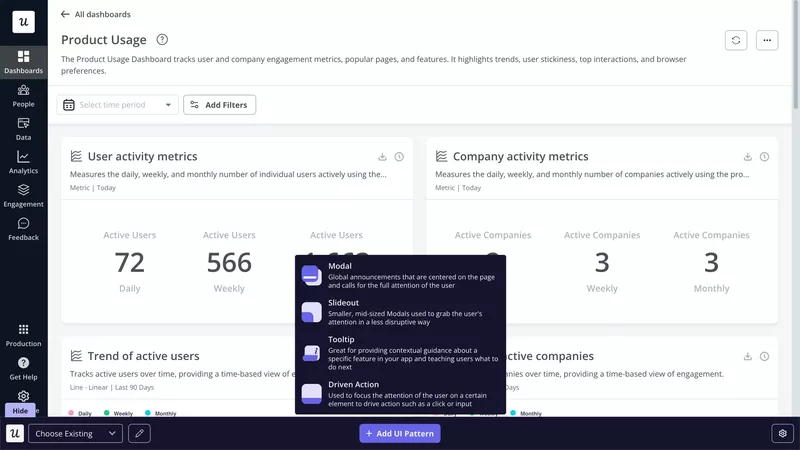
- Contextual triggers. You can set up different types of in-app events (clicks, hovers, or even a combination of those into one) and trigger engagement flows when those events occur. This way you can ensure that the right messages get delivered to the right person at the right time, increasing the chances of engagement.
- AI writing assistant. Using our built-in AI writing assistant, you can refine your copy and find a version that resonates with users. You can ask AI to expand, shorten, or rephrase until it meets your expectations.
- A/B and multivariate testing. Userpilot enables you to run experiments using different variants of an in-app message to discover the variation that drives most conversions and optimize your flow around it.
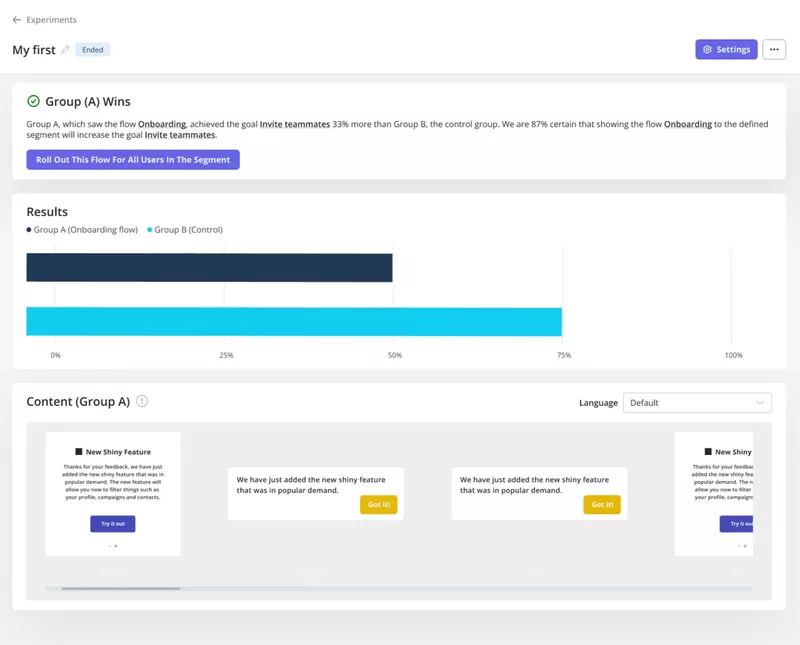
- Auto capture: Record all important user interactions( including Clicks, Text input changes, and Form submissions) by default without manually tagging them. This allows you to later analyze engagement with reports and identify areas for improvement.
- Analytics dashboards: Visualize and track key customer engagement metrics like active users, feature adoption rate, and number of sessions at a glance.
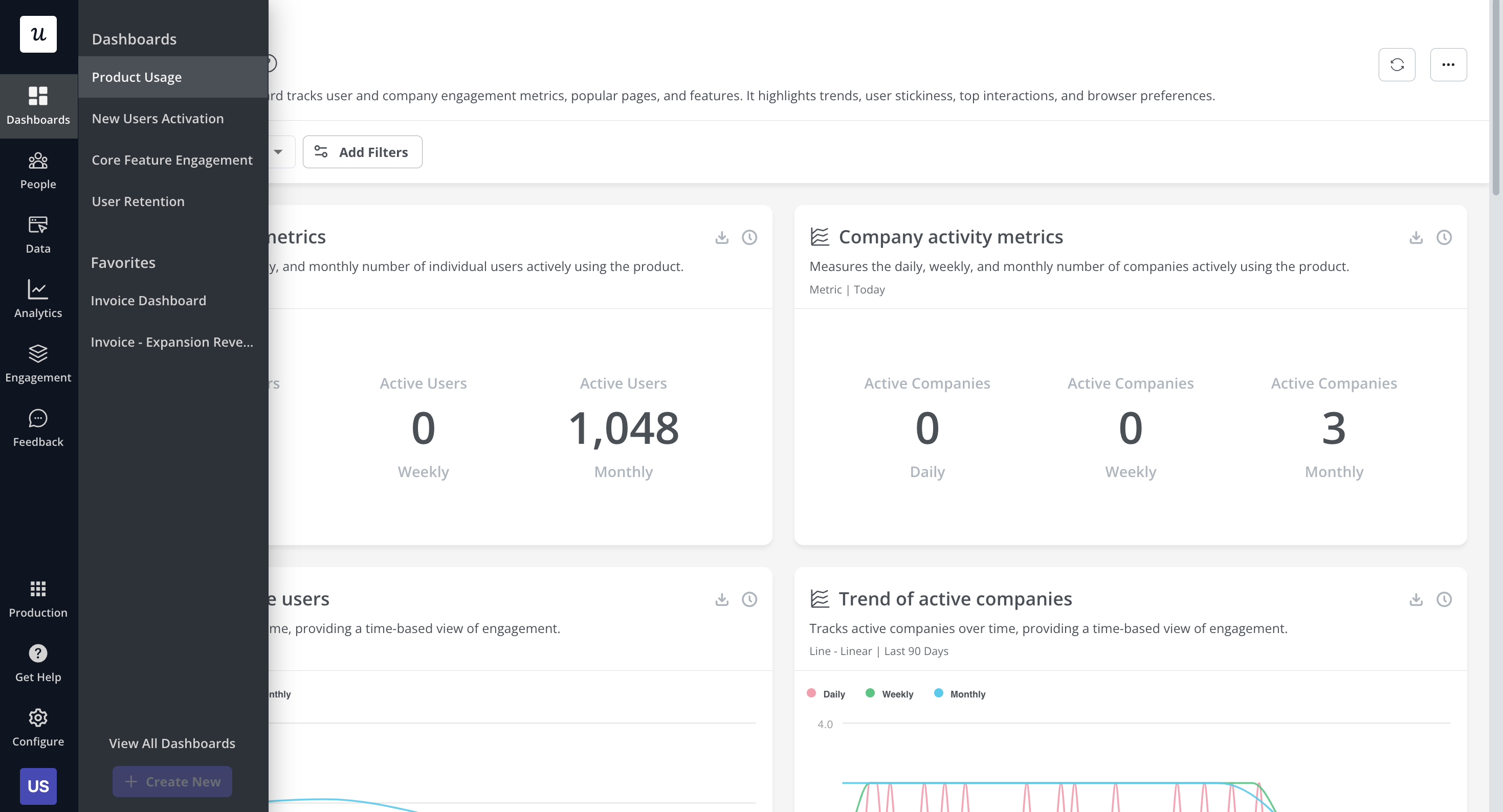
Pricing
Here’s an overview of Userpilot’s pricing plans:
- Starter: The entry-level Starter plan costs $299/month(billed annually) and includes features like segmentation, product analytics, reporting, user engagement, NPS feedback, and customization.
- Growth: The Growth plan uses custom pricing and includes features like resource centers, advanced event-based triggers, unlimited feature tagging, AI-powered content localization, EU hosting options, and a dedicated customer success manager.
- Enterprise: The Enterprise plan uses custom pricing and includes all the features from Starter + Growth plus custom roles/permissions, access to premium integrations, priority support, custom contract, SLA, SAML SSO, activity logs, security audit, and compliance (SOC 2/GDPR).
2. UserGuiding – best customer interaction platform for small businesses
UserGuiding is a no-code product adoption tool that lets users create in-app guides.
Since it’s more affordable than similar platforms, Userguuding is especially a popular choice amongst small companies on a tight budget.
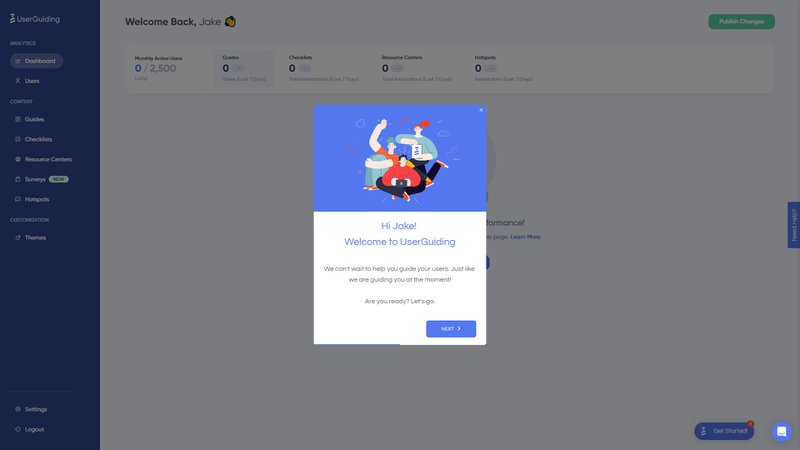
Key features
Here’s a brief overview of UserGuiding’s customer interactions and engagement features:
- Interactive guides. Create interactive elements, such as product tours, tooltips, and pop-ups, to help keep users engaged and increase the likelihood that they’ll complete the onboarding process.
- Onboarding checklists. With Userguiding’s checklists, you can prompt new users toward key actions and meaningfully engage users right from the start of their journey. Userguiding lets you customize checklist colors to match your brand palette and gamify it with celebratory animations, all this code-free.
- Resource center. Userguiding’s resource center places all your educational material regarding your product in a single place within your app, giving timely support to customers, removing friction, and ensuring seamless engagement.
Pricing.
UserGuiding’s pricing model consists of three plans:
- Basic – costs $89 per month, supports up to 2500 MAUs;
- Professional – costs $389 per month, supports up to 20.000 MAUs, guides won’t have Userguiding watermark;
- Corporate – starts at $689+ per month, custom MAUs, comes with personalized coaching sessions with an account executive.
3. Pendo – best customer engagement tool for mobile apps
Pendo is a product experience software with premium customer engagement tools for mobile applications.
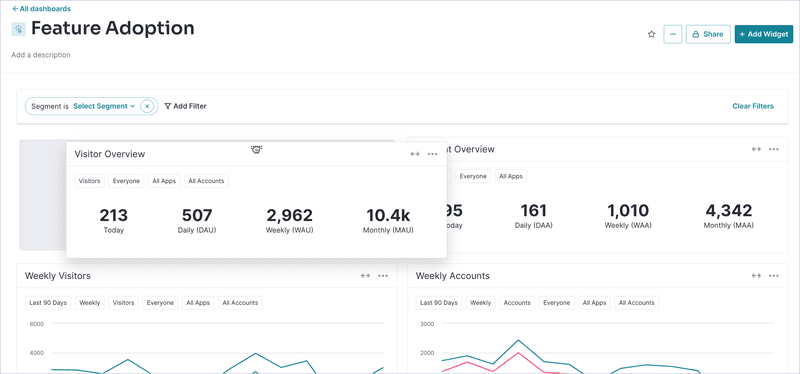
Key features
Here’s a summary of Pendo’s customer engagement features:
- Auto-generated guides. Powered by Pendo’s artificial intelligence, generate in-app product tours according to your preferred parameters, from the number of steps in a guide to the tone of voice employed.
- Flow triggers. The activation options let you set different conditions under which an onboarding flow should be triggered. These include users interacting with a tagged element, using a particular type of device, landing on a specific URL, or matching a specified segment.
- AI chatbot. Pendo’s AI chatbot integrated into its resource center can not only answer common FAQs but also pull out a relevant support document from the knowledge base upon request, saving users a lot of time they would otherwise waste scrolling.
Pricing
Pendo has a freemium version, but its uses are quite limited since certain core features are excluded, and usage volume is capped at just 500 monthly active users (MAUs).
The Starter plan has an initial price of $7,000 per year for a total of 2,000 MAUs. However, the price increases based on the number of MAUs your product accommodates. This could lead to situations where you’re paying $35,000 annually once you hit 10,000 MAUs.
Pendo also offers two other plans — Growth and Portfolio — both of which use custom quote-based pricing.
4. MoEngage – best AI-powered in-app messaging platform
MoEngage is a customer engagement platform with tools for omnichannel customer interactions at your disposal.
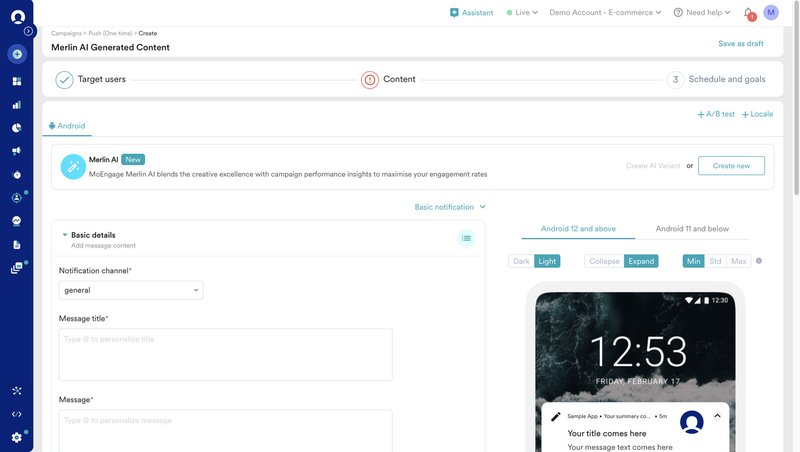
Key features
Here’s a rundown of MoEngage’s customer engagement features:
- Website personalization tools. MoEngage has a suite of no-code website personalization tools to optimize user experience and create relevant content for anonymous visitors.
- Omnichannel messaging campaigns. You can build campaigns across various channels, including SMS, email, push notifications, and in-app messaging.
- AI-powered campaign optimization. MoEngage’s AI can help you choose the best-performing content variant to present to customers according to past customer behavior. The AI also identifies the best time to send messages to customers, increasing the likelihood of customers reading and connecting with your messages.
Pricing
MoEngage offers a free Starter plan that’s capped at 10,000 monthly tracked users (MTUs).
MoEngage offers two paid plans (Growth, and Enterprise) calculated based on your MTUs.
5. Whatfix – best employee engagement platform
Whatfix is a digital platform with user onboarding and employee engagement capabilities.
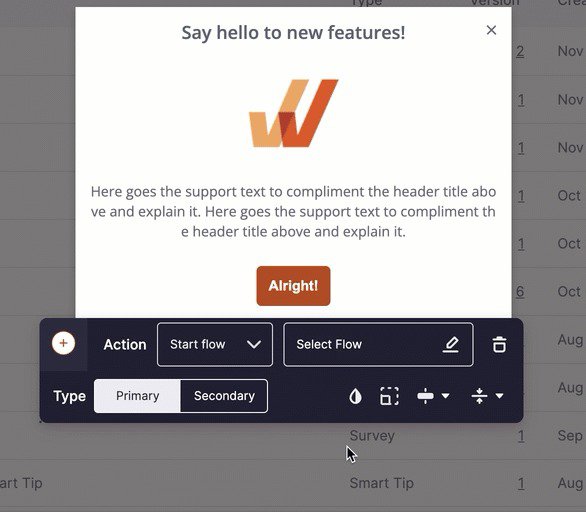
Key features
Here’s a brief overview of Whatfix’s employee engagement tools:
- Interactive walkthroughs. Whatfix’s interactive walkthroughs guide users as they navigate around the product, providing relevant knowledge when users need it and when they’re most receptive to receiving it. This can also be perfect for training work-from-home employees.
- On-demand support. This is done through “Smart Tips” that integrate with your knowledge base, FAQs, and more to deliver support when and where your users need it. All the user has to do is just click on the flashing bacon / help widget and contextual guidance will be triggered.
- Pop-Ups and Beacons. These standalone messages alert users to changes and new features, promote marketing campaigns and engage users.
Pricing
Whatfix offers three paid plans (Standard, Premium, and Enterprise) calculated depending on whether Whatfix would be used internally (among employees) or externally (among customers).
6. Hubspot – best customer relationship management platform
HubSpot is an inbound marketing and sales software that helps foster customer relationships.
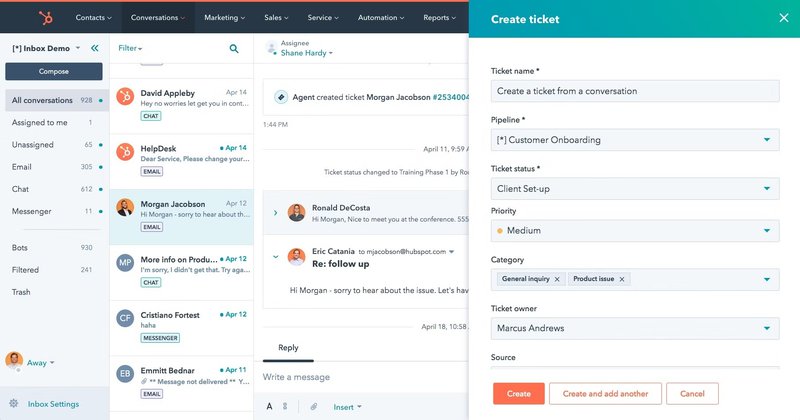
Key features
Here’s a summary of Hubspot’s customer engagement capabilities:
- Centralized customer engagement. Hubspot’s omnichannel customer service tool allows teams to connect with customers across all messaging channels. With a centralized inbox, customer service teams can easily switch between channels to address customer issues, manage customer relationships, and foster customer satisfaction.
- Automated customer service. This tool automates the ticketing process and marks high-priority tickets as first in line, removing the need to manually sift through customer data. This lets customer service reps address core issues faster, creating a satisfying customer experience.
Pricing
Hubspot offers three paid plans for its Service Hub (starting at Starter’s $15/month per seat billed annually, up to Enterprise’s $130/month per seat billed annually).
Hubspot also offers a free plan with tools like CRM, live chat, analytics, and more for up to five users.
7. Zendesk – best omnichannel engagement platform
Zendesk is among the top customer engagement platforms, prioritizing customer service, brand loyalty, and customer experience.
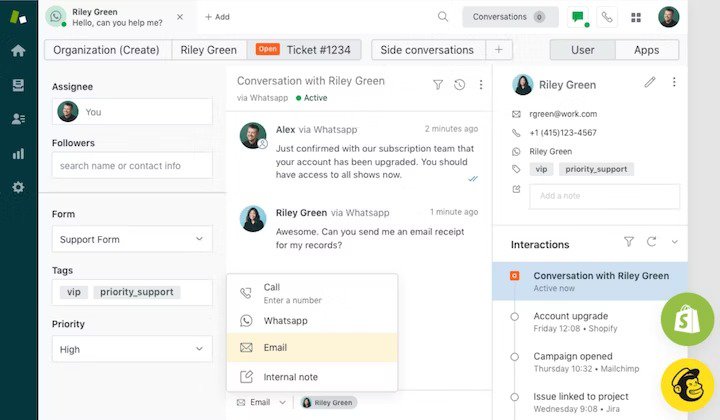
Key features
Here’s a rundown of Zendesk’s customer engagement functionalities:
- Integrated voice software. Zendesk Talk is an integrated voice software that allows customers to call customer service reps and sales reps directly.
- Conversational CRM systems. Zendesk’s CRM tool utilizes a conversational approach to live chat and engagement, personalizing every encounter whenever customers interact with teams. With AI capabilities and omnichannel messaging, never miss a beat on important moments that keep customers engaged and cared for.
Pricing
Zendesk offers three paid plans (Starting at Suite Team’s $55/month per agent billed annually, up to Suite Professional’s $115/month per agent billed annually) as well as a plan for Enterprises that’s available upon request. Zendesk also offers a 30-day free trial for their Suite Professional tier.
8. Drift – best customer engagement software for sales and marketing teams
Drift is a conversational marketing and customer engagement platform focused on customer relationship management bolstered by AI.
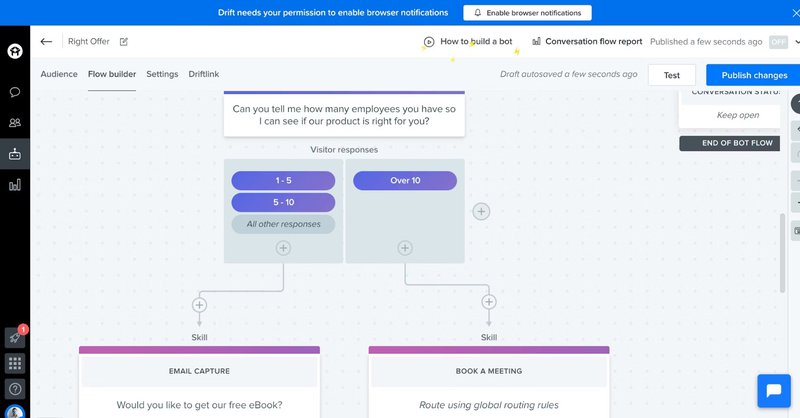
Key features
Here’s a brief overview of Drift’s customer engagement software tools for marketing and sales teams:
- Customer prospecting. Drift’s customer prospecting tool helps teams close leads quickly and more effectively. With AI-powered insights to mark high-intent customers and omnichannel outreach for communication, this tool makes it one of the most effective sales tools of the year.
- Live chat and chatbots. Drift’s live chat and chatbots feature is made incredibly effective with Drift’s AI functionality, allowing teams to deflect concerns with possible solutions found in the research center, leaving human customer service reps to focus on more important tickets.
Pricing
Drift offers three paid plans. Premium, its lowest tier made for small businesses, starts at $2,500/month billed annually. The higher two tiers, Advanced and Enterprise, employ a quote-based pricing model.
9. Kangaroo – best customer engagement platform for loyalty programs
Kangaroo is one of the best customer engagement software focused on developing customer loyalty throughout the customer lifecycle.
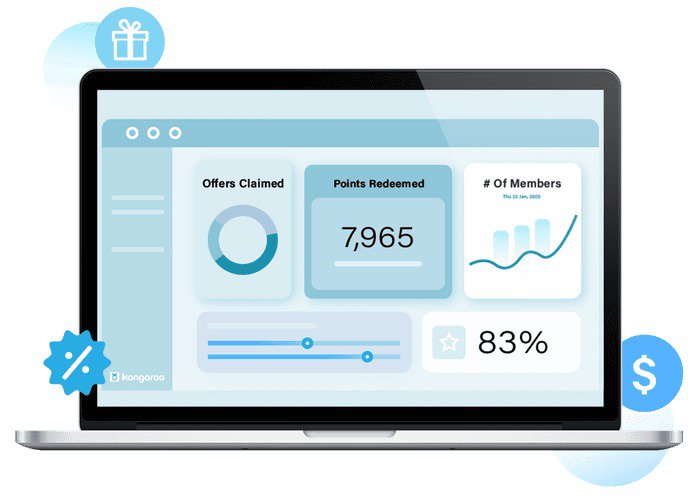
Key features
Here’s a summary of Kangaroo’s customer experience management platform:
- Gamification. With contests, sweepstakes, and giveaways teams can easily set up marketing campaigns that will keep customers on their feet.
- Marketing automation. The marketing automation tool empowers small businesses to market efficiently and effectively even without the dedicated manpower to run it.
Pricing
Kangaroo offers four paid plans (starting at Loyalty Essential’s $59/month up to Ultimate Plus’s $299/month).
10. Intercom – best chatbot tool for driving engagement
Intercom is a customer engagement tool and customer service solution that heavily utilizes AI for its features
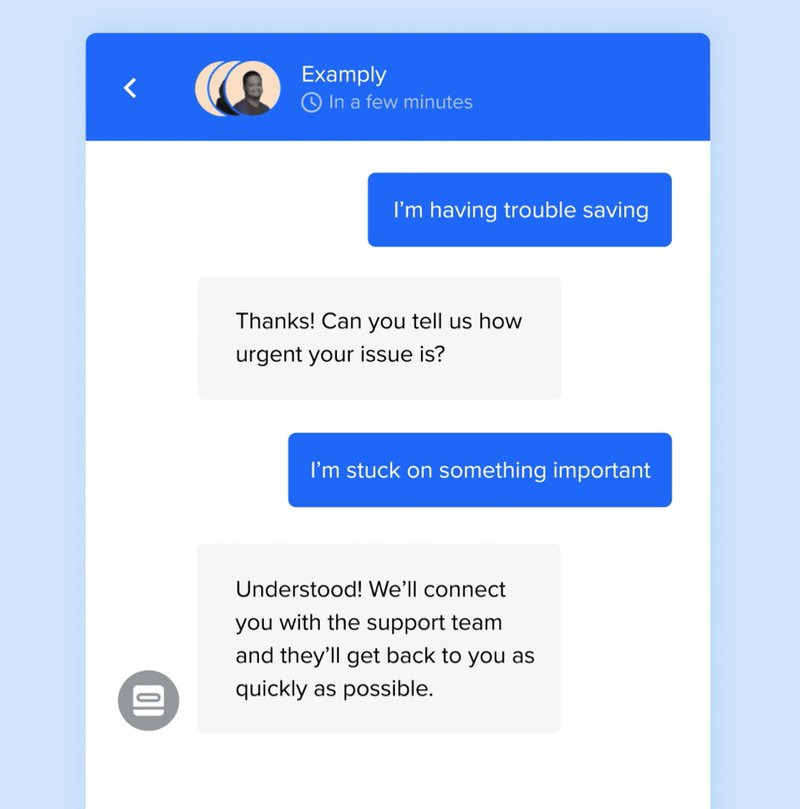
Key features
Here’s a rundown of Intercom’s chatbot tool features for driving engagement:
- Multilingual support. Intercom offers multilingual support for 45 languages right out of the box. Intercom’s Fin AI will communicate in any of the available languages, increasing your customer reach. You can also find all live chat exchanges from different channels within a single unified inbox.
- Seamless handoff. The seamless handoff feature lets human agents close deals quicker after Fin AI handles most of the tedious work. When the sophisticated AI has exhausted all facets or is unable to answer queries, it can automatically hand over tickets to human agents.
- Help center. Intercom lets you build a help center for your product, incorporating resources from your database or Intercom’s own.
Pricing
Intercom offers three paid plans (starting at Essential’s $39/month per user, up to Expert’s $139/month per user), and a 14-day free trial.
11. Sprout Social – best social media engagement software
Sprout Social is a social media management software and one of the finest customer engagement platforms that specializes in social media engagement and marketing.
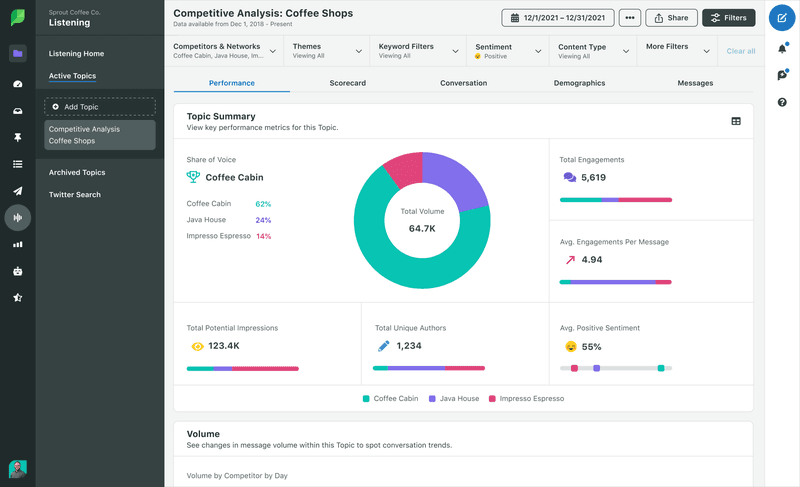
Key features
Here’s a rundown of Sprout Social’s social media engagement tools:
- Brand monitoring. Sprout Social’s sentiment detection tool surveys the social landscape to build a sentiment analysis on the brand. With AI, Sprout Social marks every @mentions with a corresponding sentiment, empowering teams to respond appropriately.
- Case assignment and message tagging. Message tagging helps organize tickets and automate replies, while case assignment reduces redundancy with customer care and helps teams answer high-priority inquiries first.
Pricing
Sprout Social offers three paid plans (starting at Standard’s $199/month per user billed annually, up to Advanced’s $399/month per user billed annually), as well as a 30-day free trial. Sprout Social also offers a plan for enterprises that is available upon request.
12. Pushwoosh – best push notification platform for driving customer engagement
Pushwoosh is an omnichannel customer engagement platform best known for push notifications to drive engagement.
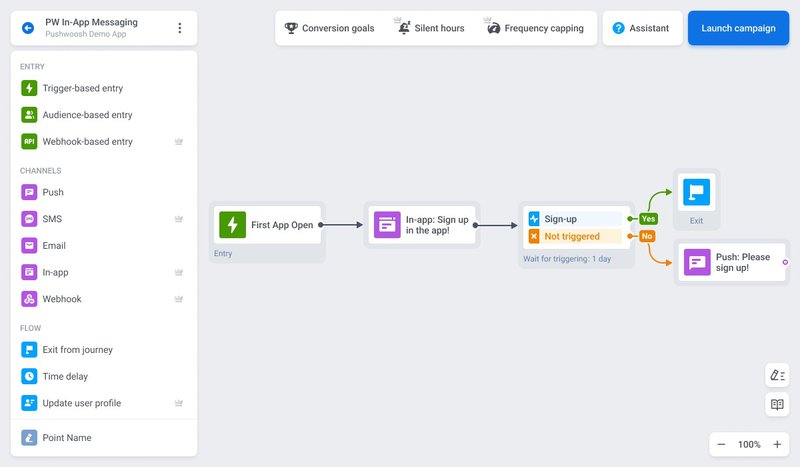
Key features
Here’s a brief overview of Pushwoosh’s push notification tools:
- Push notifications. Pushwoosh’s flagship feature, push notifications allows for engaging customers who aren’t currently logged in to your product. Paired with other channels like SMS and email, ensure that all the bases of your marketing efforts are covered.
- In-app messaging. The no-code editor gives teams superb flexibility to create in-app notifications even without the engineering know-how.
- Customer journey builder. With its drag-and-drop visual builder, you can map out customer journeys and set triggers for messages across multiple channels at each touchpoint.
Pricing
Pushwoosh offers a subscription plan priced at $49/month as well as a custom plan that is available upon request.
Conclusion
Customer engagement is detrimental to business growth. Only through meaningfully engaging with the product customers will experience value and integrate the product into their lives.
Are you ready to engage your customers effectively? Sign up for a free Userpilot demo today and discover the power of a customer engagement platform.
Customer engagement software FAQs
What does a customer engagement platform do?
What is the difference between CRM and customer engagement platform?
CRM systems are primarily designed to manage a company’s interactions with current and potential customers. Their main goal is to improve business relationships, streamline processes, and increase sales.
In contrast, customer engagement platforms are built to actively engage customers. Their purpose is to build a deeper relationship with customers by providing personalized and meaningful interactions.
The functionality of a CRM focuses on sales, marketing, and customer support functions. This includes managing contact information, tracking sales leads, conducting sales forecasting, and providing customer service.
CEPs, on the other hand, offer tools for communication across multiple channels, like email or in-app messaging.
What features should your customer engagement platform support?
Here are a few of the key ones:
- Omnichannel communication (to connect channels like in-app messaging, email, SMS, social media, web chat).
- Personalization and segmentation (to customize the messaging based on user behavior).
- Automation and workflow management.
- Real-time analytics and reporting (for data-driven decision-making).
- Integrations (with CRM, social media management, CDP software, etc.).







